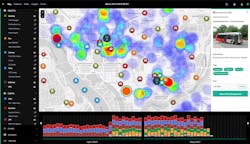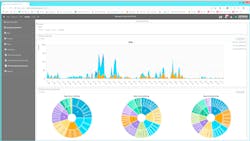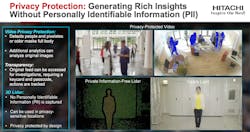Video: A Gateway to the Internet of Things
Just the mere mention of deploying an Internet of Things (IoT) project can be enough to give some business leaders heart palpitations.
What problems are we actually trying to solve? Where do we start? What departmental or policy siloes will have to be broken down? What do we connect and how do we do it? All are questions that amount to what seems like an insurmountable task. But procrastination on these critical deployments can be crucial as Gartner research vice president, Nick Jones notes, “the Internet of Things will continue to deliver new opportunities for digital business innovation for the next decade… CIOs who master innovative IoT trends have the opportunity to lead digital innovation in their business.”
Luckily, most businesses already have the resources they need to tap into a trend that’s transforming industries: video intelligence. Video cameras are nearly everywhere – at intersections, in airports, on factory floors, and in retail stores – tasked with keeping us and our property safe and secure. But the data these cameras capture is only living up to a fraction of its potential – if all of this data was transformed into insights through recent innovations, and then complemented with other types of data, we would have the means for a much more data-driven world, leading to better efficiencies and less waste, improved public safety, and better experience for citizens, customers, and passengers. This makes video a top-tier data type that should be an important part of any organizations data strategy.
Gleaning Insights from Video
Organizations around the world are already transforming video from a simple, reactive tool that must be constantly monitored by humans, into a dynamic and largely automated solution that provides proactive insights and alerts that help us improve our quality of life. Thanks to recent technological advances, it’s possible to connect these simple tools into an integrated, intelligent system that can address challenges in ways never before possible. Combine video with computer vision and artificial intelligence (AI), and it becomes a rich source of data that delivers deep insights into human behavior, safety, and business operations – insights that can address some of a business’ and society’s most pressing problems.
Video’s power has grown tremendously in the past few years, as the accuracy of computer vision has soared over just the past decade. For example, error rates for computer vision image labeling have plunged from 28.5% in 2010 to 2.5% in 2018 – surpassing human accuracy several years ago.
When analytics and video come together, they become a transformative force that can deliver actionable insights for data-driven decisions. With video data now available from almost everywhere in the physical world, video insights can support decisions about traffic and parking, transit decisions, customer behavior and preferences, manufacturing quality assurance, and much more.
Have a look at just some of the possibilities:
Strengthen Manufacturing: every year, 20,000 warehouse workers in the U.S. suffer serious workplace injuries. These injuries are serious in human terms to the individuals and their teams, and they also cost employers more than $35,000 in direct expenses per incident. With smart video, manufacturers can receive real-time alerts about safety violations, institute data-driven safety programs, improve incident response times, strengthen worker training programs and predict maintenance needs. This makes the workplace safer while significantly reducing business costs.
Streamline Transportation: some transit organizations use video intelligence to detect when stations get crowded so that they can quickly deploy the right number of buses or train cars. With smart video, drivers know where parking spots are available and when mass transit would be a better option compared to driving. And cities can identify recurring traffic challenges – such as double-parking by rideshare drivers – and implement practical solutions like designated passenger loading zones.
Enhance Pedestrian Safety: throughout the world, thousands of pedestrians are hit and killed each year as they cross railroad tracks and traffic intersections. In the U.S. alone, nearly 6,000 pedestrians were killed in 2017, a 25-year high. Many of these collisions could be avoided by adding AI software to traffic cameras. AI software can use video data to prevent collisions by issuing immediate alerts to drivers when pedestrians are near, or train operators when a car is idling on the train track or to bus drivers when a person is crossing the street. By collecting data on near misses, city governments can improve safety and reduce incidents at the most dangerous locations.
Create Smart Campuses: universities are using video analytics, and data visualization and integration to improve operational efficiency and campus safety for students and staff. By using video data to understand and optimize classroom and building usage, universities are able to use the resources they have more efficiently and push out new infrastructure construction by several years, saving millions in operating expenses. Some of the campus data is even being exposed to students for research and class projects, giving them a more hands-on and relevant education for the technological jobs they will be applying to after they graduate.
Video as The On-ramp to IoT
Although video has been in our lives for a long time, we are just beginning to tap into its full potential. By adding AI software to existing cameras and stored footage, we can better address a wide array of social and business problems – and ultimately create a safer, smarter, healthier and more secure world for all of us. Some of the new capabilities that are making possible all of the use cases above include:
- Video analytics, pairing video with computer vision and AI to unleash business, operational and safety intelligence
- Holistic insights from video, IoT, and business data to provide a 360-deg. understanding of operations
- The ability to store and manage the high volume and speed of video with solutions built for its unique needs
These capabilities start with a foundation of video as a prime data opportunity and combine it with data from other IoT sensors, business data from ERP and process systems, etc. to gain deeper insights into how each element impacts another.
So what happens when you apply the transformative power of video, big data analytics, and AI to a smart space? You set the stage for an exponential return on investment, taking advantage of a common infrastructure that enables multiple entities to share data insights over a single pane of glass – and unlock multiple outcomes.
For example, cameras are already common in many cities, and they have been steadily collecting video data for years. Their initial focus might have been narrow, such as to improve public safety or manage traffic congestion. However, with a smart city initiative, the city could use the same cameras to track and decrease traffic – and less traffic results in lower emissions. Or those video cameras and infrastructure could be used to collect economic data that may be applied to determine real estate values – and create new business opportunities.
Additionally, organizations involved in a smart city initiative can easily share data between entities for better insights and collaboration. By incorporating cameras into a smart city strategy, the city can improve the quality of life for its citizens while improving economic development opportunities. The city’s return on its original investment can be vastly expanded by using data that’s already being collected in new ways, thus extending the benefits of video insights to a greater majority of its citizens.
But isn’t Privacy a Concern?
Privacy, data governance, and security are an important part of any data conversation – and we are all concerned about maintaining control over our identities and personally identifiable information (PII) – so it’s great news that smart video can protect privacy and improve transparency even as it gathers and analyzes vast amounts of data. That’s because AI software automatically obscures and protects people in security videos in real-time through pixilation, while movement and actions remain recognizable.
In other privacy-sensitive areas, 3D Lidar uses lasers to sense the world in real-time and can be leveraged to glean insights without capturing any private information – a particularly tailor-made solution for sensitive areas that demand privacy, such as hospitals and schools.
When potentially sensitive video footage needs to be viewed, access can be granted to authorized officers with proper credentials and identification cards. The actions performed by these authorized individuals on the system are recorded and can be audited for full transparency, making it GDPR-ready. Adding additional security measures into the data pipeline, intelligent data operations provide data orchestration, governance, security, privacy protection, and compliance to further protect the identities of those captured on video, and ensure that the usage of data is transparent.As we advance further into a world where data becomes more and more valuable, these innovations will provide ever-richer insights that improve our quality of life, economies, and sustainability, all while keeping our privacy protected.
About the Author
Justin Bean
Global Director of Smart Spaces and Video Intelligence Marketing
Justin Bean is the Director of Smart Spaces and Video Intelligence Marketing at Hitachi Vantara, which brings IoT solutions to market with the mission of social innovation. Justin has worked with Silicon Valley startups and Fortune 500s that are applying IoT and other disruptive technologies to improve our lives and cities. He has worked in the US, Japan, and South Africa on projects that include smart cities, smart parking, electric vehicles, renewable energy, machine learning and 3D printing. He was the recipient of the THINK Prize in from renowned innovation and design firm IDEO for their Financial Empowerment Challenge. He also served in Americorps NCCC with a focus on empowering disadvantaged communities, holds an MBA in sustainable management, and resides in San Francisco, California.



